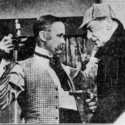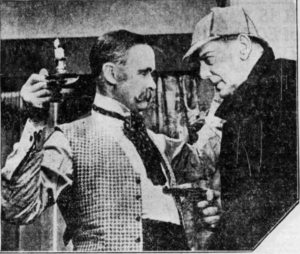A Scion Society of The Baker Street Irregulars

Technicians Keep Diligently At Television Experiments (April 3, 1938)
Eye’s Deception of Mind Creates Real Television Problem
Original Caption: A tense scene during the telecast of Sir Arthur Conan Doyle’s “The Three Garridebs,” featuring Sherlock Holmes.
Arthur Maitland as John Garrideb, Louis Hector as Sherlock Holmes
If seeing were believing, the puzzles of television entertainment would be as simple as ABC, but since the eyes deceive the mind and since intelligence graves deception, a number of bright young men in Radio City have a headache.
They are wondering whether it will be necessary to un-learn some principles of make-believe that have come down from the Greeks, and also whether they must create new forms of program technique. When television demands something, however impossible, it usually wins.
After one year of pioneering experimentation in the television studios of the National Broadcasting company, Thomas H. Hutchinson, production director, declared that the promise of television dramatics dazzles the imagination, nothwithstanding that our knowledge of producing and acting for this art is still primitive.
Follows Peculiar Pattern
“Television development has followed a peculiar pattern,” said Hutchinson. “We have devoted ourselves almost exclusively to the technical side, and now, about 50 years after the first technical experimentation, we are beginning to explore program possibilities.
“The upshot is that television today is a lopsided affair. The mechanical, electrical and engineering sides have advanced on a common front, but production work has lagged far behind. The remarkable resolution of the television pictures transmitted from the NBC aerial atop the Empire State building proves that engineers have achieved wonderful results, but we are just beginning the era of program development.”
Deceiving the eyes with television drama calls for highly-skilled artisians. The scene and costume designer worked previously in Hollywood, the script writer had a combination of stage, radio and movie experience, the cameraman had a background of radio engineering and movie topography, the actors had experience before the microphone, behind the footlights and on the lot and the production director has weathered the climates of Hollywood, Broadway and radio.
Audience Reaction Important
Hutchinson believes that the mass audience reaction is a decisive factor in the success of many first class performances. Some shows which make hits with theater audiences would be complete flops if played for a typical radio audience.
Since television entertainment must meet the requirements of a home audience before all else, the producers have the job of discovering the peculiar psychological traits and habits of small groups gathered in the living room. It appears that the supreme test for a television program is the way it affects three or four people at a time. If it can control their emotions, that is to make them laugh, cry and sympathize with one thing and another, the chances are good for television.
To date the most ambitous undertaking of the NBC experimenters was the production of a Sherlock Holmes mystery drama, “The Three Garridebs,” based on Sir Arthur Conan Doyle’s narrative and involving seven actors. It ran continuously for 36 minutes, the longest drama ever telecast on this side of the world.
100 Families See Play
As the picture impulses sped over the peaks of Manhattan, approximately 100 fortunate families in the New York metropolitan area sat before receivers in their homes and witnessed the clever sleuthing of Detective Holmes and Dr. Watson. This perfect pair of cluehounds solved the mystery of the Garrideb brothers, of course, and incidently, they helped to solve a few major ysteries that had been plaguing Hutchinson and his actors.
This telecast established a new relationship between sight and sound. It revealed the “intelligence” of the television camera. It definitely established television as a magic medium for heightening dramatic suspenses. And it pointed to mystery and action as teh keynotes of space-picture drama.
The home spectators, composed of NBC officials and their families, felt the completer oblivion to surroundings that is a counterpart of good dramatic illusion. They were transported by the sights and sounds – that is, they were well-deceived by their eyes. The illusion was so convincing that they almost felt the presence of strange people in the room.
Suspense and Action
“From this experience it appears that television will make the most of material that emphasizes suspense and action,” Hutchinson said. “You can see how well a detective drama fits this prescription. In projecting an actor’s face through space , we focus our major appeal on the speculator’s eye, which is arrested by action, and on the intelligene which is intrigues by any good suspense like mystery.
“The appeal of hearing does not rank so high in television, for with this medium we can even dispense with sound altogether and present pantomines that would be as convincing make-believe as the old silent movies. But sound accompaniment naturally makes telecasting even more realistic.”
Hutchinson now is convinced that any good story can be presented in television, but it must be adapted exclusively for this medium. It must be exceptionally well written, acted and produced.
The NBC experimenters have arrived at a set of production cost figures, and these indicate that a first class television drama will cost considerably more that a straight radio show, a rather stiff price for a one-time performance.
This much is certain, however. Television drama must come up to the level of Hollywood production, but at a fraction of Hollywood’s costs. It may be some time before television is self-supporting.
This story was originally published in the April 3, 1938 edition of the Tampa Sunday Tribune with no author byline. TFG claims no copyright to this posting. Double-click on the photograph to see a scan of the full newspaper page.


Sorry, comments are closed for this post.